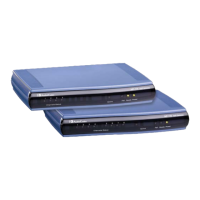User's Manual 668 Document #: LTRT-27045
Mediant 1000B Gateway & E-SBC
Parameter Description
matching routing rules that are assigned Cost Groups, the
first-matched routing rule without an assigned Cost Group is
considered as the lowest cost route and thus, chosen as the
preferred route.
33.4 Configuring SIP Response Codes for Alternative
Routing Reasons
The Alternative Routing Reasons table lets you configure up to 20 SIP response codes for
call release (termination) reasons. If a call (outgoing SIP dialog-initiating methods, e.g.,
INVITE, OPTIONS, and SUBSCRIBE messages) is released as a result of a configured
SIP code (e.g., SIP 406), the device searches for an alternative routing rule for the call in
the IP-to-IP Routing table (see ''Configuring SBC IP-to-IP Routing Rules'' on page 656).
Typically, the device performs alternative routing when there is no response at all to an
INVITE message. This is done after a user-defined number of INVITE re-transmissions,
configured by the SIPMaxRtx parameter. In such a scenario, the device issues itself the
SIP response code 408 (Request Timeout). Alternative routing is only done if you have
configured the response code in the Alternative Routing Reasons table.
You can also configure alternative routing for the following proprietary response codes, if
configured in the table, that are issued by the device itself:
805 IP Profile Call Limit: The device generates the response code when Call
Admission Control (CAC) limits (e.g., maximum concurrent calls) are exceeded for an
IP Group (or SRD). The CAC rules are configured in the Admission Control table (see
''Configuring Admission Control'' on page
643). When this occurs, the device sends a
SIP 480 (Temporarily Unavailable) response to the SIP entity. In such a scenario, an
alternative route configured in the IP-to-IP Routing table can be used.
806 Media Limits Exceeded: The device generates the response code when the call
is terminated due to crossed user-defined thresholds of QoE metrics such as MOS,
packet delay, and packet loss (see ''Configuring Quality of Experience Profiles'' on
page
297) and/or media bandwidth (see ''Configuring Bandwidth Profiles'' on page
302). When this occurs, the device sends a SIP 480 (Temporarily Unavailable)
response to the SIP entity. This is configured by 1) assigning an IP Group a QoE
and/or Bandwidth profile that rejects calls if the threshold is crossed, 2) configuring
806 in the Alternative Routing Reasons table and 3) configuring an alternative routing
rule.
The device also generates the response code when it rejects a call based on Quality
of Service rules due to crossed Voice Quality and Bandwidth thresholds (see
''Configuring Quality of Service Rules'' on page 306). If the response code is
configured in the table and the device rejects a call due to threshold crossing, it
searches in the IP-to-IP Routing table for an alternative routing rule.
818 Signalling Limits Exceeded: The device generates the response code when it
rejects a call based on Quality of Service rules due to crossed ASR, NER or ACD
thresholds (see ''Configuring Quality of Service Rules'' on page
306). If the response
code is configured in the table and the device rejects a call due to threshold crossing,
it searches in the IP-to-IP Routing table for an alternative routing rule.

